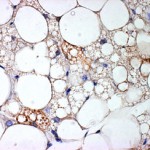The Problem With Brown Fat Stimulation
Friday, January 30, 2015Brown adipose tissue is a thermogenic organ, whose sole purpose is to burn calories, which it does with remarkable efficiency (to generate heat).
Not surprisingly, much current research focuses on harnessing this tissue to control or even reduce body weight.
Now a paper by Aaron Cypess and colleagues from the Joslin Diabetes Center in Boston, published in Cell Metabolism, describes the use of the β3-adrenergic receptor (AR) agonist mirabegron, a drug normally used to treat bladder dysfunction, to stimulate brown adipose tissue in humans.
The studies were carried out in 12 healthy young lean male volunteers, who were each given a single 200 mm dose of mirabegron.
Subsequent imaging studies using PET and CT scanning showed substantial activation of brown adipose tissue depots associated with an rise in resting metabolic rate of over 200 cal per day.
Unfortunately, these changes were accompanied by a significant rise in heart rate and blood pressure, not exactly a desired effect when it comes to reducing cardiometabolic risk.
Indeed, these “side-effects” of β3-AR stimulation has been noted before and has resulted in previous attempts to harness this system to be abandoned for human use.
Nevertheless, this study does prove the point that stimulating brown fat in humans can result in a significant increase in metabolic rate.
If this tissue is ever to be harness for weight management, researchers will need to find a way to activate this tissue without also stimulating the sympathetic nervous system (which will still leave them with the problem of heat dissipation – simply burning calories will always result in thermogenesis, which can have quite unpleasant side effects).
@DrSharma
Toronto, ON
Cypess AM, Weiner LS, Roberts-Toler C, Elía EF, Kessler SH, Kahn PA, English J, Chatman K, Trauger SA, Doria A, & Kolodny GM (2015). Activation of Human Brown Adipose Tissue by a β3-Adrenergic Receptor Agonist. Cell metabolism, 21 (1), 33-8 PMID: 25565203



